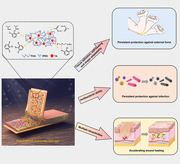- Record: found
- Abstract: found
- Article: found
Bioinspired Polyacrylic Acid‐Based Dressing: Wet Adhesive, Self‐Healing, and Multi‐Biofunctional Coacervate Hydrogel Accelerates Wound Healing

Read this article at
Abstract
Polyacrylic acid (PAA) and its derivatives are commonly used as essential matrices in wound dressings, but their weak wet adhesion restricts the clinical application. To address this issue, a PAA‐based coacervate hydrogel with strong wet adhesion capability is fabricated through a facile mixture of PAA copolymers with isoprenyl oxy poly(ethylene glycol) ether and tannic acid (TA). The poly(ethylene glycol) segments on PAA prevent the electrostatic repulsion among the ionized carboxyl groups and absorbed TA to form coacervates. The absorbed TA provides solid adhesion to dry and wet substrates via multifarious interactions, which endows the coacervate with an adhesive strength to skin of 23.4 kPa and 70% adhesion underwater. This coacervate achieves desirable self‐healing and extensible properties suitable for frequently moving joints. These investigations prove that the coacervate has strong antibacterial activity, facilitates fibroblast migration, and modulates M1/M2 polarization of macrophages. In vivo hemorrhage experiments further confirm that the coacervate dramatically shortens the hemostatic time from hundreds to tens of seconds. In addition, full‐thickness skin defect experiments demonstrate that the coacervate achieves the best therapeutic effect by significantly promoting collagen deposition, angiogenesis, and epithelialization. These results demonstrate that a PAA‐based coacervate hydrogel is a promising wound dressing for medical translation.
Abstract
A polyacrylic acid (PAA)‐based coacervate hydrogel with robust wet adhesion and self‐healing capabilities is obtained through a mixture of PAA copolymers and tannic acid. This coacervate hydrogel promotes fibroblast migration, regulates macrophage polarization, kills bacteria, and facilitates wound healing via improving collagen deposition, angiogenesis, and re‐epithelialization, suggesting its considerable potential as a wound dressing.
